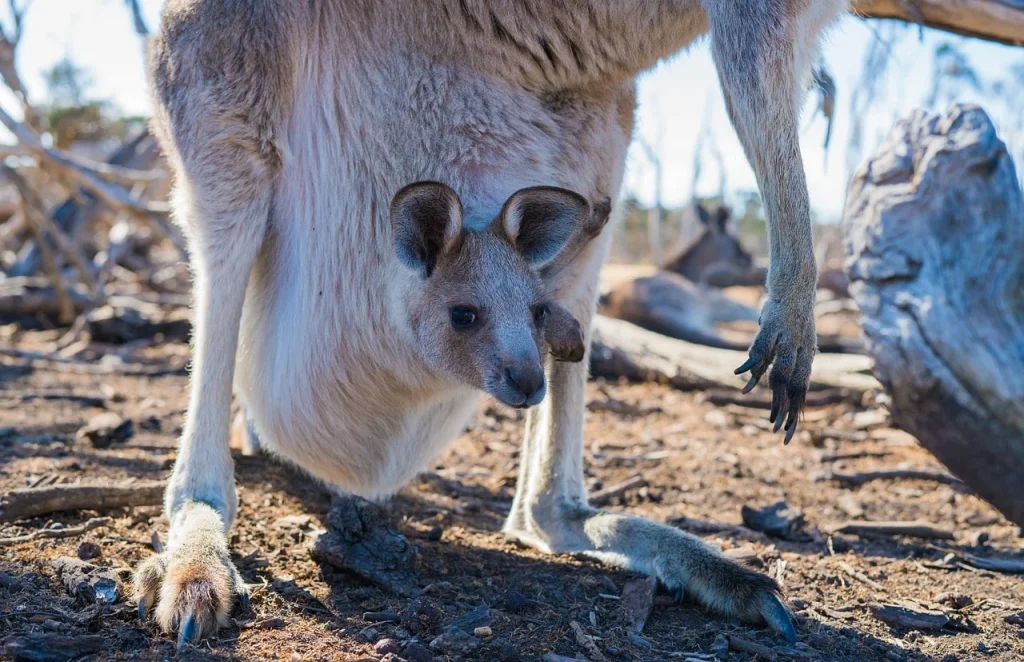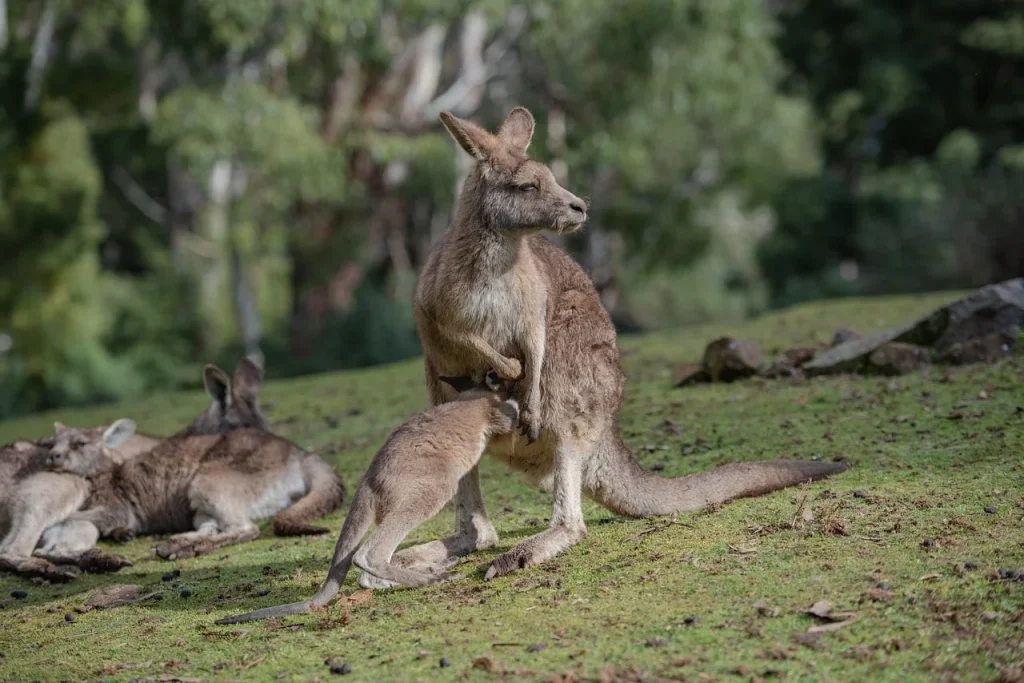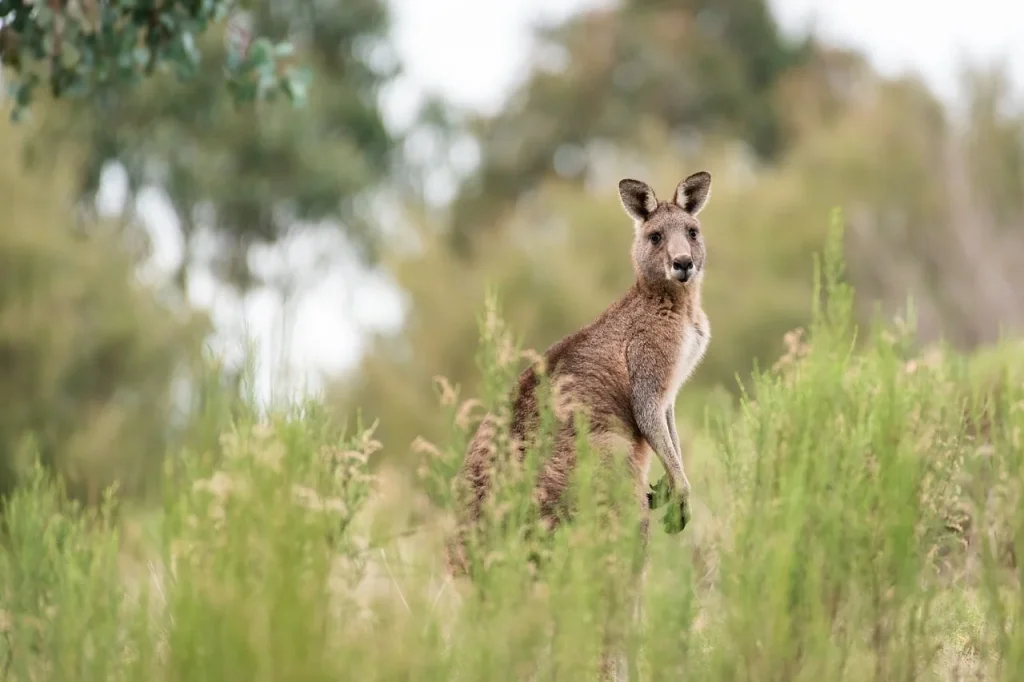Kangaroos are truly remarkable creatures that seem to defy the ordinary. From their ability to leap great distances to their unique way of raising their young, they are full of surprises.
For example, a newborn kangaroo is as small as a jellybean. Can you imagine that tiny joey making its way to its mother’s pouch? And here’s a funny fact: kangaroos sometimes “box” with each other to show who’s boss! There’s so much more to explore about these wonderful marsupials. Let’s hop to it!
Kangaroos, the hoppiest animals in Australia.
Anonymous
Kangaroo Facts
Let’s start our journey. Be sure to read each fact carefully, as there’s a quiz at the end to test your kangaroo expertise!
- These animals can’t walk backwards due to their bulky tails and large hind feet.
- They are capable of delaying pregnancy, a phenomenon known as embryonic diapause, until conditions are favorable.
- The red species is the largest of its kind, with males reaching up to 90 kilograms.
- Groups are known as mobs, which enhance protection against predators.
- A newborn is extremely small at birth, measuring only about 2.5 centimeters long.
- Their powerful hind legs can deliver a kick capable of seriously injuring potential threats.
- Speeds of over 60 kilometers per hour can be reached when they are in full sprint.
- Swimming skills are surprisingly adept; they use their legs independently to swim.
- Mother kangaroos use their pouches to nurture and protect their joeys until they are mature enough to survive outside.
- Their tail is used as a fifth limb for balance and support when standing upright.
- Sweating is not their method for cooling down; instead, they lick their forearms to reduce body temperature.
- Each foot has four toes, with the two middle toes fused together—a condition known as syndactyly.
- They have excellent hearing and can rotate their ears in different directions without moving their head.

- Vision includes peripheral abilities, allowing them to detect motion from a wide angle.
- They rarely need to drink water, extracting most of their moisture from their grassy diet.
- Their lifespan in the wild usually spans more than 20 years.
- During courtship, males engage in boxing as a display of dominance.
- Joeys stay in the pouch for up to eight months before being independent enough to leave.
- Grass forms the primary component of their diet, though they occasionally consume leaves.
- Females generally give birth to one joey at a time, though twins have been recorded in rare instances.
- Red kangaroos exhibit a lighter coloration in females, generally a blue-grey.
- Their ability to leap over obstacles includes covering distances up to nine meters in a single bound.
- They exhibit a behavior known as “pronking” or stotting, where they spring into the air to alert others of danger.
- Albino individuals occur naturally, though they are extremely rare in the wild.
- When threatened, they will lead predators into water bodies and use their strong legs to hold the predator under water.
- Eastern greys have been observed to form stable social groups known as “clans.”
- They communicate distress through a series of coughs or clicks.
- Foregut fermentation allows them to efficiently digest their fibrous diet.

- Increased urbanization has led to more frequent encounters with vehicles, often leading to accidents.
- They can survive in diverse habitats, from beaches to forests, adapting to various environmental conditions.
- Muscular adaptations provide the ability to conserve energy when hopping at high speeds.
- During the dry season, they dig shallow waterholes to access groundwater.
- Pouch muscles allow the mother to control the opening, protecting the joey from falling out.
- Their eyes are positioned high on the sides of their head, giving them a nearly 360-degree view.
- Tails store fat, serving as reserves during times of food scarcity.
- Marking territory involves scratching the ground and depositing scents from specialized glands.
- Predators include dingoes and large birds of prey for the younger or smaller individuals.
- They can use their robust body to breach fences and barriers, creating challenges for local farmers.

- Their coat thickness and color vary significantly across different regions and species.
- Research indicates they can communicate with humans through gaze and body movement when in need.
- Genetic diversity is relatively high among populations, aiding their adaptation to environmental changes.
- Their foot thumping can serve as a warning to others of approaching danger.
- Seasonal migrations occur in response to changing food and water availability.
- Social hierarchy within mobs can influence mating and access to resources.
- Reflective tape on road signs has been used successfully to reduce vehicle collisions by making the signs more visible to them at night.
- They exhibit a high degree of parental care, with mothers often seen grooming their young.
- Fossil records suggest ancestors of modern types were arboreal.
- Due to their large size, they have few natural enemies, but younger individuals are vulnerable to predation.
- Conservation efforts focus on habitat protection and reducing human-wildlife conflict.
- Climate change poses a significant threat to their habitat through altered rainfall patterns and increased droughts.
Kangaroo Myths

Now that we’ve explored the facts, let’s dive into distinguishing the myths from the truth about kangaroos. Prepare to be surprised as we uncover the reality behind some common misconceptions.
- Kangaroos Can Move Backwards
It is often believed that they can move backwards, but this is not the case. Due to their long, muscular tails and strong hind legs, movement in reverse is restricted. They rely on forward motion for mobility. - Kangaroos Carry Water in Their Pouches
Contrary to popular belief, their pouches are not used to store water. The pouch’s primary function is to nurture and protect their young, known as joeys, until they are mature enough to survive outside. - All Kangaroos Are Large
While the image of a towering, muscular kangaroo is prevalent, not all kangaroos are large. Species like the musky rat-kangaroo are much smaller, with some individuals weighing less than a kilogram. - Kangaroos Live Only in Australia
Although they are synonymous with Australia, they are not confined exclusively to this continent. They can also be found in New Guinea. Several species of tree-kangaroos are native to both Australia and New Guinea. - Kangaroos Are Domesticatable Animals
Many assume they can be domesticated, like dogs or cats. However, kangaroos are wild animals with specific environmental and social needs that are difficult to meet in a domestic setting. They are best suited to the wild, where they can roam freely.
No products found.
Kangaroo Quotes

We continue to the quotes section. Below, you will find my favorite quotes about kangaroos. Feel free to share yours in the comments so I can add them to the list as well.
Kangaroos, with their strong legs and curious eyes, are a symbol of the wild and free spirit of Australia.
Unknown
This quote by an unknown author reflects the powerful and inquisitive nature of kangaroos, symbolizing the untamed essence of Australia’s wildlife.
The kangaroo’s ability to leap and bound is a testament to nature’s ingenuity.
David Attenborough
David Attenborough’s quote marvels at the kangaroo’s extraordinary jumping ability, showcasing nature’s inventive adaptations.
Kangaroos are the essence of Australian wildlife, embodying the strength and resilience of the land.
Steve Irwin
Steve Irwin praises kangaroos as iconic representations of Australia’s robust and enduring natural environment.
Observing a kangaroo in the wild is like witnessing a piece of Australia’s soul.
Bindi Irwin
Bindi Irwin captures the essence of seeing a kangaroo in its natural habitat, equating it to experiencing a core part of Australia’s identity.
Kangaroos remind us that even the most unusual creatures have a place in the world’s tapestry of life.
Jane Goodall
Jane Goodall’s quote underscores the importance of kangaroos in the biodiversity of the planet, celebrating their unique role in nature.
Kangaroo FAQ

As we hop towards the end of our journey, the next section features frequently asked questions. Remember, a quiz awaits, so keep your eyes sharp and your mind alert as you read on!
- Why do kangaroos have pouches?
They have pouches to carry and nurture their young, known as joeys. After birth, the tiny joey crawls into its mother’s pouch, where it continues to develop, safely protected and nourished. - Are kangaroos dangerous?
They are generally peaceful animals but can become aggressive if threatened, especially during the mating season or if they perceive a threat to their young. It’s best to keep a respectful distance. - Can kangaroos swim?
Yes, they are surprisingly good swimmers! They use their powerful legs to propel themselves in water, and they often swim to escape predators or to find new grazing areas. - What do kangaroos eat?
They are herbivores, primarily grazing on grasses and shrubs. Their diet mainly consists of vegetation, which they are adapted to digest efficiently thanks to their specialized stomachs. - How high can kangaroos jump?
They can leap over obstacles up to 3 meters (about 10 feet) high and can cover distances of up to 8 meters (26 feet) in a single bound when they are moving quickly.
No products found.
Kangaroo Trivia

Welcome to the great kangaroo quiz! Hop along and answer correctly, or you might just find your pockets mysteriously filled with eucalyptus leaves!
Kangaroo Merch
If you are a true fan of kangaroos, then you definitely need to check out our merchandise. You can find T-shirts, hoodies, mugs, and tote bags for your favorite designs. Feel free to check out all the other designs in our shop.
Conclusion
As we finish our journey through the world of kangaroos, it’s clear that these animals are not just Australian icons but also incredible survivors who adapted perfectly to their environment. They hop effortlessly across vast landscapes, defend themselves with skill, and nurture their young with care.
They remind us of the wonders of wildlife and the importance of preserving such unique species for future generations. Their existence enriches our understanding of nature and biodiversity. Till next time, stay curious and explore more. Cheers.
1 Source Used For This Article

